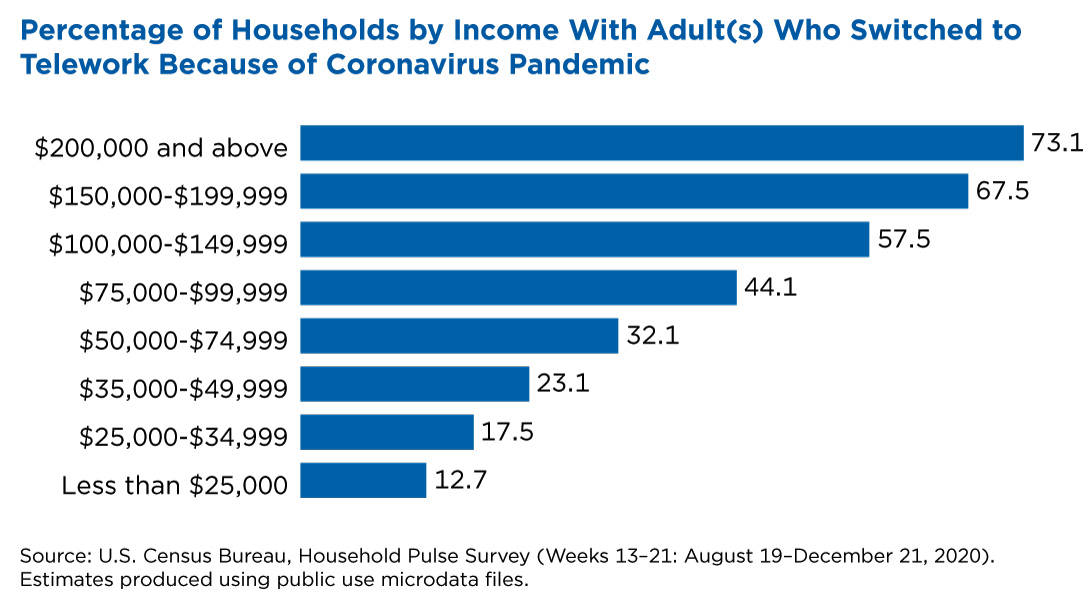By U.S. Census Bureau staff
More than a third of U.S. households reported working from home more frequently than before the pandemic, but the percentage who made the switch varied widely across sociodemographic groups.
Households with members who teleworked more frequently reported higher levels of income and education and better health than those in which no one changed their typical in-person work in response to the COVID-19 pandemic.
Among those in poor health, 4 in 5 (79.9%) reported that no one in their household switched to telework or changed their telework habits, compared to just over half (52.4%) of those in excellent health.
Since August 2020, the U.S. Census Bureau has asked participants in the Household Pulse Survey: “Working from home is sometimes referred to as telework. Did any adults in this household substitute some or all of their typical in-person work for telework because of the coronavirus pandemic, including yourself?”
Among those surveyed between Aug. 19 and Dec. 21, 36.9% answered “yes.” This covers a period when the Household Pulse Survey asked questions on both teleworking and respondents’ health status.
Teleworking and income
Those who substituted some or all of their typical in-person work for telework tended to have higher household incomes than those who did not switch to telework.
In the highest-earning households — those with annual incomes of $200,000 or more — 73.1% switched to telework. This is more than double the percentage (32.1%) of households with incomes between $50,000 and $74,999, a range that includes the 2019 median U.S. household income ($65,712).
Lowest-earning households were less likely to switch to telework. Only 12.7% of households earning under $25,000 reported teleworking in lieu of in-person work.
Teleworking and education
Educational attainment — closely linked to household income — is another key differentiating factor in the share of households with workers who switched to telework during the pandemic.
Those with a bachelor’s degree or higher were more than three times as likely as those with a high school education or GED only to have an adult in their household substitute in-person work for telework: 61.7% compared to 19.1%.
Teleworking and health
How respondents described their health status also related to teleworking patterns.
When asked to rate their health (as excellent, very good, good, fair or poor), those who reported excellent health were more than twice as likely as those who reported poor health to have had an adult in their household substitute in-person work for telework (47.6% versus 20.1%, respectively).
Among those in poor health, 4 in 5 (79.9%) reported that no one in their household switched to telework or changed their telework habits, compared to just over half (52.4%) of those in excellent health.
Who switched to telework?
Changing telework patterns have been a major feature of the COVID-19 pandemic, as many workers transitioned from commuting to a workplace to working from home.
However, even outside of the context of the COVID-19 pandemic, income, education, and health are closely correlated and their relationship to telework is one of a wide array of social and economic outcomes of interest to researchers and policymakers.
The new experimental survey is designed to quickly and efficiently deploy data collected on how people’s lives have been impacted by the coronavirus pandemic.
Information about teleworking has been included in the survey since Phase 2, which began last August and released new data every two weeks.
Estimates in this analysis were generated by combining the data from weeks 13- 21, ending Dec. 21, 2020. Methods for combining data and calculating summary statistics using replicate weights are described in the source and accuracy statements for each data release.
• Writers Joey Marshall, Charlynn Burd and Michael Burrows are survey statisticians in the Census Bureau’s Journey to Work and Migration Statistics Branch.
Talk to us
Please share your story tips by emailing editor@kentreporter.com.
To share your opinion for publication, submit a letter through our website https://www.kentreporter.com/submit-letter/. Include your name, address and daytime phone number. (We’ll only publish your name and hometown.) Please keep letters to 300 words or less.

